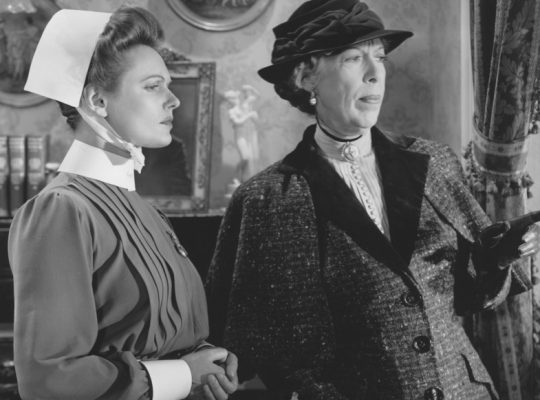Nurse Edith Cavell (1939)

Toronto Film Society presented Nurse Edith Cavell (1939) on Sunday, November 11, 2007 in a double bill with Broken Lullaby as part of the Season 60 Sunday Afternoon Film Buffs, Programme 2.
Production Company: Imperiado Pictures Ltd. Director: Herbert Wilcox. Screenplay: Michael Hogan, based on the story “Dawn” by Reginald Berkeley and the novel by Edith Cavell. Music: Anthony Collins. Cinematography: Joseph . August, Freddie Young. Editor: Elmo Williams. Art Director: Lawrence P. Williams. Set Decorator: Darrell Silvera. Special Effects: Vernon L. Walker.
Cast: Anna Neagle (Nurse Edith Cavell), Edna May Oliver (Countess de Mavon), George Sanders (Captain Heinrichs), May Robson (Madame Repard), ZaSu Pitts (Madame Moulin), H.B. Warner (Hugh Gibson), Sophie Stewart (Sister Williams), Mary Howard (Nurse O’Brien), Robert Coote (Bungey).
Edith Cavell is scarcely remembered now, but after the First World War she and her story were widely known. “Edith” became a very popular French and Belgian girls’ name; chanteuse Edith Piaf, born just two months after Cavell’s death, was one of those named after her. Many streets and memorials around the world — even a mountain in Jasper National park — were named in Cavell’s honour. Just south of Pape and Danforth in Toronto, Dresden Avenue was renamed Cavell Avenue.
ANNA NEAGLE (1904 – 1986) led a life that sounds like a rags-to-riches movie plot. She was born in a working-class district of London, became a phenomenally popular movie star and wound up a highly respected Dame Commander of the British Empire. In the postwar period, she was voted England’s favourite actress for seven straight years (a record — no one else has ever come close). She excelled at portraying tasteful, ladylike heroines and her films ranged from musical comedies to historical costume dramas. Neagle was never a critical favourite, but she was very pretty and appealing, and the public warmed to her. The romance of her private life was appealing, too: producer/director Herbert Wilcox met her by chance in 1931, fell in love with her and subsequently made almost all her movies. Theirs was one of the most successful partnerships ever in British cinema. After working together for 12 years, they were finally married in 1943, and remained together until his death in 1977.
After a few movies that didn’t quite jell, Neagle and Wilcox scored their first hit with Nell Gwynne (1934), the sort of historical costume drama that became her specialty. In 1937, just after the ban on representing Queen Victoria on the British stage or screen was lifted, the duo released Victoria the Great (1937). It was an enormous success — so much so that Wilcox immediately remade it, in Technicolor and with different incidents, as Sixty Glorious Years (1938). Neagle became firmly associated with the character, especially during the war years when the first part of the first film and the second half of the second one were spliced together and reissued under the title Queen Victoria. Neagle followed up her Technicolor Victoria with another British heroine, Nurse Edith Cavell in 1939. Inspiring heroines really were her forte; in time, she also played Florence Nightingale and WWII heroine Odette (1950). The rest of her films were musicals and romances. Tastes changed in the 1950s and there were fewer parts for genteel, gracious ladies as the decade went on. Neagle retired from films but appeared in stage productions until Parkinson’s Disease finally slowed her down in the 1980s.

Edna May Oliver Like other superb character actors, EDNA MAY OLIVER (1883 – 1942) remains a treat and a treasure. She was born Edna May Nutter in Malden, Massachusetts (and one can understand why she changed the name). She studied music extensively and quit school at 14 to pursue an operatic career, but her voice was damaged by overwork and bad weather. She soon found success as an actress, but even as a teenager she was assigned older character parts. On Broadway, she gained attention in 1917 at age 34, playing a comically dour old Quaker aunt in Jerome Kern’s “Oh, Boy!” In 1927, she originated the role of Parthy, Cap’n Andy Hawks’ wife in “Show Boat”, and repeated it in the 1932 Broadway revival. (Oliver turned down the part in the 1936 screen version, in order to play the Nurse in Romeo and Juliet.) She married stockbroker David Pratt in 1928, but they divorced five years later. Under contract to RKO in 1930, she became popular in a series of comedy films with Wheeler and Woolsey and eventually starred in 10 films at the studio. Her most popular star vehicles were as spinster sleuth Hildegarde Withers in a series of mystery-comedies she made with James Gleason. Oliver’s distinctive features and voice were replicated in many animated cartoons of the period, usually saying “Oh, reaaallly” in an imitation of her familiar voice and attitude. Oliver moved to MGM in 1935, and subsequently appeared in big budget movies. She was featured in many film versions of classic literature, including Alice in Wonderland and Little Women (both 1933), A Tale of Two Cities (1935), David Copperfield (1935), Romeo and Juliet (1936) and Pride and Prejudice (1940). Versatile Edna also appeared in the Irving Berlin musical comedy Second Fiddle (1939), in which she danced in a big production number with Tyrone Power as her partner. She received a Best Supporting Actress Oscar nomination for her work in 1939’s Drums Along the Mohawk. After playing an exasperatingly healthy hypochondriac in 1941’s Lydia, Oliver died unexpectedly on her 59th birthday in 1942, of an intestinal disorder.
Notes by Paddy Benham










Leave a Reply